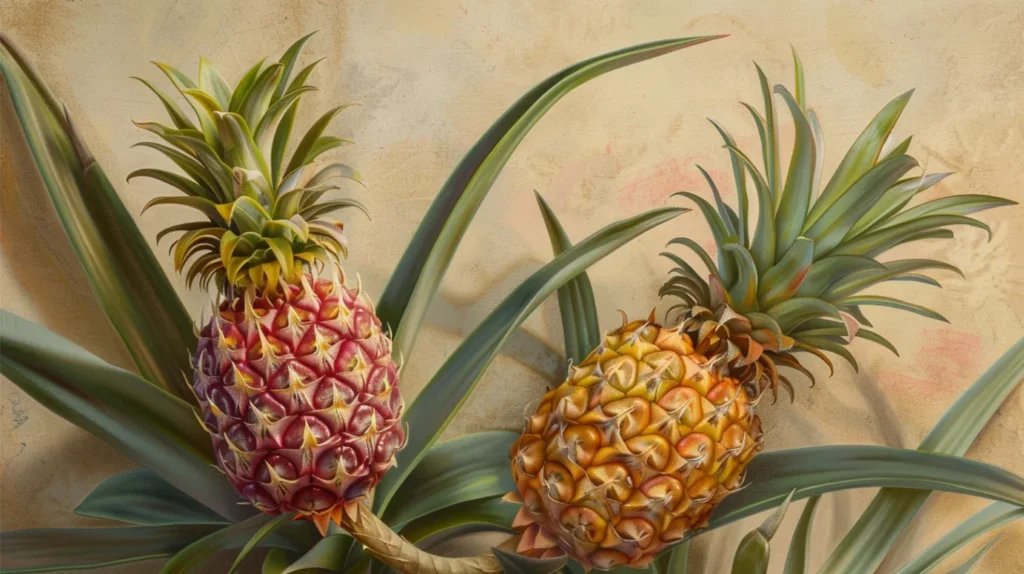Pineapples are a delicious and nutritious tropical fruit that have captivated taste buds around the world. But have you ever wondered how these spiky, sweet delights grow? In this blog post, we’ll dive into the fascinating world of pineapple cultivation and explore the journey from plant to plate.
The Pineapple Plant
Pineapples are part of the Bromeliaceae family, which includes over 3,000 species of plants. The pineapple plant is a herbaceous perennial, meaning it can live for several years and regrows after each harvest. Pineapple plants typically grow to a height of 1-1.5 meters (3-5 feet). The leaves are long, sword-shaped, and arranged in a spiral pattern around the central stem. The fruit develops from the center of the plant, surrounded by a rosette of leaves.
Fun fact: Pineapples are actually made up of many individual berries that fuse together around the central core!
Growing Conditions

Pineapples thrive in tropical and subtropical climates with specific growing conditions. They grow best in temperatures between 20-30°C (68-86°F) and are sensitive to frost, unable to tolerate temperatures below 10°C (50°F). Pineapple plants require full sun exposure, with a minimum of 6 hours of direct sunlight per day. Well-draining, sandy loam soils with a pH between 4.5 and 6.5 are ideal for pineapple growth. The soil should be rich in organic matter. Pineapples have moderate water requirements, needing consistent moisture but cannot tolerate waterlogged soil.
Propagation Methods
Pineapples can be propagated through several methods. The leafy top of the pineapple fruit, known as the crown, can be twisted off and planted to grow a new plant. Slips, which are small plantlets that grow between the leaves of the main stem, can be carefully removed and planted. Suckers, small shoots that emerge from the base of the plant, can also be separated from the parent plant and used for propagation.
Pineapple plants grown from crowns or slips typically take 18-24 months to produce fruit, while suckers may bear fruit within 12-18 months.
Pineapple Cultivation

Pineapple cultivation involves several key stages. Planting is the first step, where pineapple propagules (crowns, slips, or suckers) are planted in prepared beds or rows. Spacing between plants varies depending on the variety and desired fruit size. Regular fertilization with a balanced fertilizer containing nitrogen, phosphorus, and potassium is essential for healthy growth. Foliar fertilization can also be applied.
Weed control is important in pineapple cultivation. Mulching and manual weeding help control weed growth and maintain soil moisture. Pest and disease management is another crucial aspect. Common pests include mealybugs, scale insects, and nematodes. Diseases such as root rot, heart rot, and yellow spot virus can affect pineapple plants.
Flower induction is a critical stage in pineapple cultivation. Pineapples are naturally induced to flower by short day lengths and cool temperatures. However, commercial growers often use chemicals like calcium carbide or ethylene to induce flowering and synchronize fruit development.
Harvesting and Post-Harvest Handling
Pineapples are typically ready for harvest 18-24 months after planting. The fruits are harvested by hand when they reach the desired size and maturity. Maturity indicators include fruit size, color change, and aroma development. The crown is usually left intact during harvesting.
After harvest, pineapples undergo post-harvest handling to ensure quality and extend shelf life. The fruits are cleaned, sorted, and graded based on size and appearance. They may be treated with fungicides to prevent post-harvest diseases. Pineapples are then packed in crates or boxes for transportation to markets or processing facilities.
Health Benefits and Culinary Uses
Pineapples are not only delicious but also packed with nutrients and health benefits. They are an excellent source of vitamin C, manganese, and dietary fiber. Pineapples contain bromelain, an enzyme with anti-inflammatory and digestive properties. Studies suggest that consuming pineapples may aid digestion, boost immunity, and promote bone health.
In the culinary world, pineapples are incredibly versatile. They can be enjoyed fresh, grilled, or baked. Pineapples are used in a wide range of dishes, from sweet desserts like pineapple upside-down cake to savory recipes like pineapple fried rice. They also make a refreshing addition to smoothies, juices, and cocktails.
Conclusion
The journey of a pineapple from plant to plate is a fascinating one. From the unique characteristics of the pineapple plant to the specific growing conditions and cultivation practices, every step plays a crucial role in producing the sweet, juicy fruits we love. With their delightful flavor and impressive health benefits, it’s no wonder pineapples have become a beloved tropical fruit worldwide.
So the next time you enjoy a slice of pineapple, take a moment to appreciate the incredible process that brought it from the field to your fork. And remember, for more interesting food facts and information, be sure to visit FoodFactsHub, your go-to resource for all things culinary!

